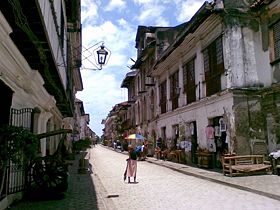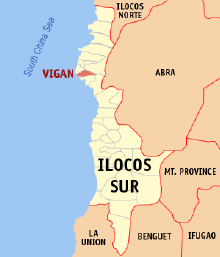Difference between revisions of "Vigan" - New World Encyclopedia
Dan Davies (talk | contribs) |
Dan Davies (talk | contribs) m |
||
| Line 97: | Line 97: | ||
<center> | <center> | ||
<gallery> | <gallery> | ||
| − | + | Image:IMGP1608.JPG|An example of a typical "bahay na bato" seen in Vigan | |
| − | + | Image:Baluarte1.jpg|Baluarte, a mini-zoo in Vigan City | |
| − | + | Image:Baluarte2.jpg|Some animals roam freely inside Baluarte | |
</gallery> | </gallery> | ||
</center> | </center> | ||
| Line 123: | Line 123: | ||
{{credits|Vigan_City|246897366|}} | {{credits|Vigan_City|246897366|}} | ||
| + | http://whc.unesco.org/en/list/502/video<!-- | ||
| + | Narration Text | ||
| + | |||
| + | Vigan – which is located in the north of the island of Luzon in the Philippines – began its history as a colonial port under Spanish rule in 1574. Originally a trading post for commerce with China, 80% of Vigan's population is of mixed Chinese and Filipino origin. | ||
| + | |||
| + | The Abra River produced gold and glistened in gold, hence the name meaning "beautiful bank". Crisologo Street, the main street running along the centre of town only allows horse carts to pass. 30 or so historic buildings line the kilometre-long pavement – they are built in stone in a Spanish style. The upper part is built with wood. What you see here is the influence of Chinese architecture. | ||
| + | |||
| + | A family came to live here in 1943. It was the family of a general from the Japanese Imperial Army which occupied the town during World War II. The General and his family took up residence in a typical Vigan-style home. The General's wife was in fact a Filipino. Sliding doors were fitted into the living room, the general's favourite. But the screens were made of thinly polished Capiz shells rather than Japanese Washi paper. The war began to turn into a nightmare for the Japanese in 1945. American troops advanced throughout the Philippines. The Japanese army usually burned down towns as they retreated. No one doubted that Vigan would meet the same fate too. Before retreating, the general decided to leave his wife and daughters in the care of the priest of this church. In doing so the General and the priest exchanged promises: "I will never set the beautiful town of Vigan alight but, in exchange, please take care of my family". The General is said to have died in battle. His family survived the war protected by the town. Vigan was the only 16th century colonial town in the Philippines to survive. | ||
| + | ----------- | ||
| + | http://whc.unesco.org/en/list/502/ | ||
| + | Brief Description | ||
| + | [Historic Town of Vigan] | ||
| + | |||
| + | Established in the 16th century, Vigan is the best-preserved example of a planned Spanish colonial town in Asia. Its architecture reflects the coming together of cultural elements from elsewhere in the Philippines, from China and from Europe, resulting in a culture and townscape that have no parallel anywhere in East and South-East Asia. | ||
| + | Justification for Inscription | ||
| + | |||
| + | Criterion (ii): Vigan represents a unique fusion of Asian building design and construction with European colonial architecture and planning. Criterion (iv): Vigan is an exceptionally intact and well preserved example of a European trading town in East and South-East Asia. | ||
| + | —> | ||
Revision as of 14:32, 4 December 2008
| Historic Town of Vigan* | |
|---|---|
| UNESCO World Heritage Site | |

| |
| State Party | |
| Type | Cultural |
| Criteria | ii, iv |
| Reference | 502 |
| Region** | Asia-Pacific |
| Inscription history | |
| Inscription | 1999 (23rd Session) |
| * Name as inscribed on World Heritage List. ** Region as classified by UNESCO. | |
The City of Vigan is a 3rd class city in the province of Ilocos Sur, Philippines. It is the capital city of Ilocos Sur. The city, located on the western coast of the large island of Luzon, facing the South China Sea. Elpidio Quirino, the 6th president of the Philippines, resided in Vigan. According to the 2007 census, it has a population of 47,246 people.
It is a World Heritage Site in that it is the most intact example of a Spanish colonial town in the Philippines, and is well-known for its cobblestone streets and a unique architecture that fuses Philippine building design and construction with European colonial architecture and planning.
History
Vigan is an island, which used to be detached from the mainland by three rivers. These rivers include the Abra River, the Mestizo River, and the Govantes River. The city is unique among the Philippine towns because it is the country’s most extensive and surviving historic city that dates back to the 16th century.
Vigan was an important coastal trading post in pre-colonial times. Long before the Spanish galleons; Chinese traders sailing from the South China Sea came to Isla de Bigan through the Mestizo River that surrounded the island. On board were sea-faring merchants that came to barter exotic goods from Asian kingdoms in exchange for gold, beeswax and other mountain products brought down by natives from the Cordilleras.
In the book, The Philippine Island, Vol. III, p. 276, Blair and Robertson, two letters of Governor General Guido de Lavezaris to King Philip II of Spain mentions: “It seemed best to send Captain Juan de Salcedo with 70 or 80 soldiers to people the coast of Los Ilocano on the shores of the river called Bigan.” Salcedo then sailed from Manila on May 20, 1572 and arrived in Vigan on June 12, 1572.
Thus, after the successful expedition and exploration of the North, Don Juan de Salcedo founded “Villa Fernandina de Vigan” in honor of King Philip II’s son, Prince Ferdinand who died at the tender age of four. From Vigan, Salcedo rounded the tip of Luzon and proceeded to pacify Camarines, Albay, and Catanduanes.
As a reward for his services to the King, Salcedo was awarded the old province of Ylocos which then composed of the Ilocos Norte, Ilocos Sur, Abra, La Union and some part of Mountain Province as his Encomienda and was accorded the title as Justicia Mayor de esta Provincia de Ylocos.
In January 1574, Salcedo returned to the capital of his encomienda, Vigan, bringing with him some Augustinian missionaries to pioneer the evangelization of Ylocos and established a Spanish city, for the purpose of controlling the neighboring country.
Governor General Gómez Pérez Dasmariñas, in his Account of encomienda dated in Manila on May 31, 1591 states: “The town of Vigan called Villa Fernandina has five or six Spanish citizens with one priest, a Justice, one Alcalde Mayor (Governor) and a Deputy. The King collects 800 tributes (equivalent to 3,200 subjects). During this period, the old Vigan was composed of 19 barrios.
In 1645-1660, Vigan was already divided into 21 Cavezas de Barangay as mentioned in the “Libro de Casamiento,” the oldest records of the parish house of Vigan found in its Archives. Separated from the naturales, the Chinese migrants have their own place of settlement called pariancillo, “Los Sangleyes del parian” and the Spanish settlers were residents in a villa called “Los Españoles de la Villa.”
Origin of the City's Name
During the Spanish conquest in the 16th century, the conquistador Juan de Salcedo headed up north to the Ilocos to establish a military base in present-day Vigan. When he first arrived in the place, at the place of present-day Barangay "Pagpartian" (Ilocano, "butchering place"—because it is the location of the city abattoir) through the Mestizo River, he noticed the lush, green plants growing along the riverbanks. He asked a native about the name of the place. The native, not understanding Spanish, thought he was asking the name of the plant, told him that they were biga'a. So Salcedo derived the city's name, "Vigan," from the plant.
Its full name at the time of its foundation was Villa Fernandina, in honor of the first born son of King Philip II of Spain. As the city grew, and the seat of the Archdiocese of Nueva Segovia transferred to the place, it was later named Ciudad Fernandina de Vigan, in honor of the reigning Spanish king.
Barangays
Vigan City is politically subdivided into 39 barangays.
|
|
|
Major Schools Based in Vigan
- University of Northern Philippines: the oldest State University in Northern Luzon, founded by virtue of Republic Act 4449, authored by the late Congressman Floro Crisologo
- Saint Paul College of Ilocos Sur]] (formerly Rosary College): the oldest privately-funded school in Ilocos Sur, founded by the Sisters of Saint Paul of Chartres in Vigan (but recently fully transferred to nearby Bantay)
- Divine Word College of Vigan: the second oldest privately-funded school in Ilocos Sur, founded by priests belonging to the Society of the Divine Word (SVD)
Gallery
- Baluarte1.jpg
Baluarte, a mini-zoo in Vigan City
- Baluarte2.jpg
Some animals roam freely inside Baluarte
See Also
Notes
External links
Links retrieved December 4, 2008.
- The Vigan City Galleries
- My Vigan
- Heritage City of Vigan
- Philippine Travel Destinations: City of Vigan
- Longanisa Vigan Festival
- Pasyalang Ilocos Sur
| |||||||
| |||||||||||
Credits
New World Encyclopedia writers and editors rewrote and completed the Wikipedia article in accordance with New World Encyclopedia standards. This article abides by terms of the Creative Commons CC-by-sa 3.0 License (CC-by-sa), which may be used and disseminated with proper attribution. Credit is due under the terms of this license that can reference both the New World Encyclopedia contributors and the selfless volunteer contributors of the Wikimedia Foundation. To cite this article click here for a list of acceptable citing formats.The history of earlier contributions by wikipedians is accessible to researchers here:
The history of this article since it was imported to New World Encyclopedia:
Note: Some restrictions may apply to use of individual images which are separately licensed.

